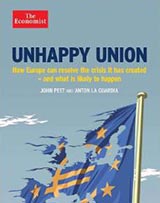
Wasn't the new currency meant to make you stronger?
Unhappy Union
It feels as if you’re gliding above a landscape while a knowledgeable companion explains you what you’re seeing, how each bit interacts with everything else, and why the landscape looks like it does today. At the end of the flight, you feel like you really know the place, how it got to be the way it is, and what could be done to make it flourish again.
“Unhappy Union,” by John Peet, Europe Editor at The Economist, and Anton La Guardia, the Economist’s Charlemagne columnist, is a concise, highly readable account of what the euro has meant so far for the European Union. Intended as a glue to bring the EU closer together, the euro ended up posing an existential threat when its design flaws became apparent, leaving a very divided EU in its wake.
As the authors rightly point out, being part of a single currency made it too easy for deficit countries to build up large imbalances and avoid reform in good times, and horribly difficult for them to adjust in hard times. If the deficit countries had kept their own currencies, the bond markets would have been more alert, demanding higher yields before the weaker countries could build up such large external deficits. During the crisis, devaluation would have made it easier for them to regain competitiveness. Still, it is likely that Europe’s currencies would have been linked in some way, so that currency pain would still have been felt by many members when the crisis struck, leading to protectionist reactions that would have undermined the single market.
But the euro turned what might have been a currency crisis into a debt crisis that has forced the hardest-hit countries into overdue reforms. Some of the less-hard-hit, such as France and Italy, which have reformed far less, pose now the greatest danger: “They are too big to fail, too big to save and too big to bully from Brussels.”
Europe’s folly was to believe that the benefits from a single currency—trade, financial integration, exchange-rate stability and economic efficiency—could be obtained on the cheap, “without the political constraints, economic flexibility, financial transfers and risk-sharing mechanisms of genuine federations.” Without such features, the crisis gained far larger proportions than anyone imagined.
And yet the euro survived, thanks to a combination of political commitment to the European project and fear of what might happen if it broke apart: without the euro or the single market, the EU would become irrelevant. So the European Central Bank stretched its mandate to preserve the euro, Ireland, Greece and Cyprus went through enormous sacrifices to stay in, Germany and other solid places staked billions of euros in rescue operations—and other countries are still lining up to join the euro club.
This is not to say that the euro has been really patched up. It has merely survived. True, some mechanisms are now in place, such as a permanent rescue fund, a banking union in the making, tougher rules to monitor budgets. But its weaker members are still suffering acutely, with higher debt ratios, crushing unemployment and threatened by deflation.
Messrs Peet and La Guardia dissect the catalogue of errors in Europe’s response, the unorthodox measures undertaken by the ECB, the role played by the IMF and the glaring differences with the American system before suggesting a way forward.
For one thing, discipline should be exerted by the markets and not by Eurocrats. For another, the credibility of the no-bail-out rule must be restored, allowing countries to go bust if they get into trouble. More-flexible markets for labour, products and services, together with greater mobility of workers and cross-border ownership of assets would provide means to adjust, in the absence of a large American-style federal budget. More federalism, without necessarily aiming for the at-present politically impossible United States of Europe, would enhance resilience. The ECB’s one-size-fits-all interest rate is a one-size-fits-none arrangement that tends to amplify economic divergence, so it should be adjusted. And Europe should operate as one coherent financial system.
Some of the priorities the authors put forth are completing the banking union, forgiving unpayable debt, creating some form of mutualisation of debt, and redressing the imbalances. Furthermore, a central budget that helps to absorb the shock when one region or another suffers a downturn would be a boon. If a Eurozone fund acted as a backstop for banks and issued European debt, the ECB could act as a lender of last resort to the European fund instead of to national governments.
The democratic deficit should be narrowed and the European Commission streamlined, appointing competent commissioners instead of using Brussels “as s dumping ground for second-division political hacks.”
All of the above measures face daunting obstacles. And the dangers to the Eurozone have not been banished. It faces a long period of stagnation with mass joblessness, and politics is becoming more radicalised, its stance more intensely anti-EU.
And Germany? The country has been conditioned to avoid any notion of leadership. “But lead it must.” It is, after all, Europe's most powerful economy and biggest creditor. It needs a political strategy for Europe that counteracts the fact that many European leaders see only the problems, inconvenience, constrains and threat of Europe, rather than its promise. They fear undoing European integration, but do not promote it either. The sad asymmetry is that “the euro has the potential to destroy the European project. Yet saving the single currency is a poor rallying-cry for European integration.” Waiting for time to cure the ills is not an option. Unless the euro can be shown to deliver prosperity and well-being, they conclude, public support for the European Union will inexorably ebb away.
